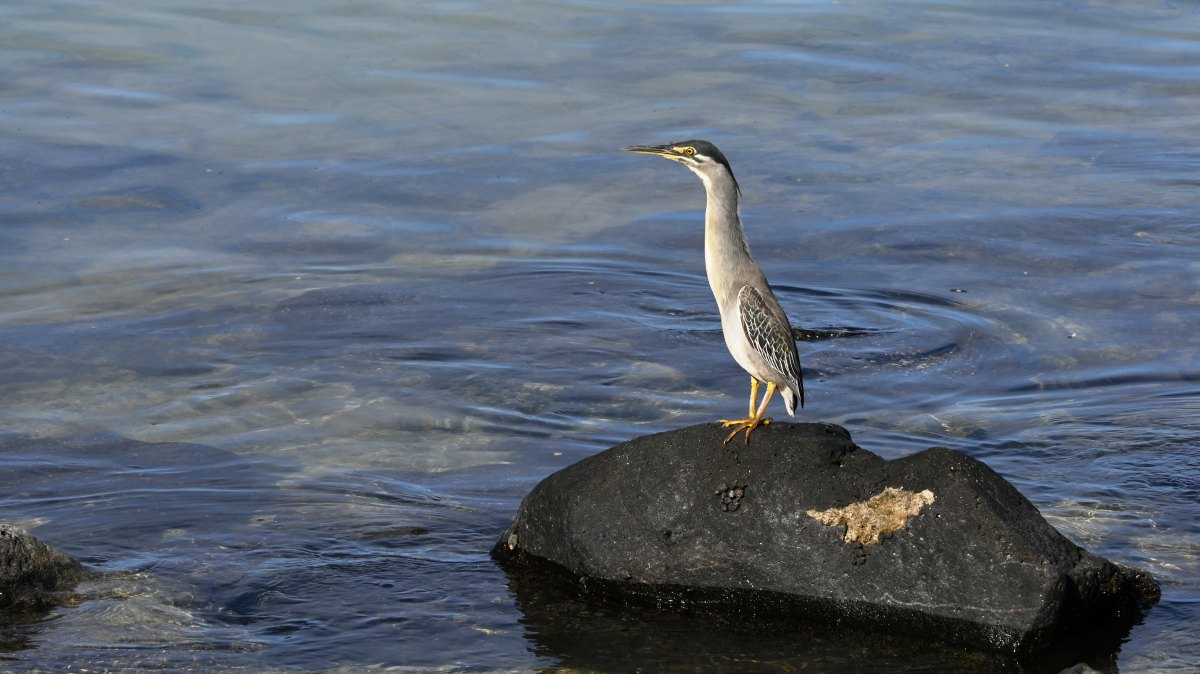
Heron on rock at Mont Choisy lagoon waiting for prey

The grey heron, a bird with a large neck, a fearsome fisherman. With its neck tucked into its shoulders, frozen like a statue, the grey heron is fascinating to observe. Inseparable from wetlands, this fearsome fisherman uses his beak like a sword to pierce the fish on his menu. Close-up on a wader that chooses the tree canopies to raise its young. The grey heron belongs to the order of ciconiiformes and to the family of ardéidés, birds of medium to very large size which are distinguished by the length of their neck, their legs and their beak. Cousin of the stork, the grey heron is the largest of the ardeidae in Europe. Its wingspan varies from 175 and 195 cm and its size ranges from 90 to 98 cm. It weighs between 600 and 1200 grams and its life span can reach 25 years. The yellow eyes of the grey heron. This wader is recognized by its size but also by its grey plumage which gives it its name. The cap, the head and the neck are white. A wide black band extends from the eyes to the nape of the neck and ends with long black egrets. Its long beak is orange while its eyes and legs are yellow. The bird has excellent lateral and frontal vision. Its particularly developed hearing makes it react to the smallest noises. The two sexes are identical but the female has shorter egrets. The grey heron, sedentary or migratory. Contrary to the storks or the cranes which extend their neck while flying, the grey heron folds up its own in order to balance the weight of the body. The legs are stretched backwards, the long, wide wings are arched. Its gait in the air gives it a unique profile. Aesthetically pleasing but slow (40 km per hour at the most), its powerful flight allows the numerous migratory populations to cover great distances. Depending on the latitude, the birds are sedentary or migratory: Siberian herons are nomadic and French herons are homely. Migratory movements are made in groups and during the day. The grey heron, very present in Europe. The grey heron lives from the north of Scandinavia and Siberia to the south of Africa, India and Indonesia. On the European continent, it can be found in several countries such as Holland, the Nordic countries, Great Britain, Germany, but also Portugal, northern Italy, Greece and everywhere in France. It usually lives on the plains up to 1000m but depending on the country, it can be found up to 2000 or 3500 meters of altitude. The grey heron lives near water and it is sometimes possible to find the bird on the beach or in the sea in Mauritius. The grey heron can be found in humid and shallow environments, near rivers, lakes, ponds, marshes and rice fields. On the coast, it roams estuaries, mangroves and mudflats. Fresh or brackish waters, it does not matter to him, as long as they are full of fish. In the off-season, the wader surveys agricultural areas in search of rodents and other terrestrial prey. It roams the open areas to hunt but perches in high trees to nest. The grey heron, solitary and gregarious at the same time. This shy animal does not let itself be approached easily and at the slightest intrusion, it stretches its neck and leaves for a more peaceful spot. The large diurnal and solitary wader (outside the mating season) is also a gregarious bird. However, it holds on to its territory and ardently defends its fishing spot against the competition that it will not hesitate to chase. The species is monogamous but the bonds of the couple last only the time of a nesting. Outside the breeding season, the birds gather for the night in dormitories in places out of reach of predators. The grey heron's favorite food: fish. Its diet consists mainly of fish, but depending on the habitat and the season, the bird may supplement it with amphibians, crustaceans, mollusks, aquatic invertebrates, reptiles, rodents (mice, shrews, voles, field mice, rats) and small birds. It may also eat plants such as buds. The grey heron can digest bones but will reject rodent hairs in the form of pellets through its beak. A very sharp hunting technique. The grey heron is a stalker. Waiting for an opportunity, it stands motionless, perched on one leg, with its neck tucked into its shoulders and its eyes riveted on the surface of the water. Once the fish is spotted, it lets it approach and, in a flash, pierces it with its sharp beak. The wader is able to grab a fish weighing more than 500 grams. The bird uses the same technique in terrestrial environment with the rodents that it watches at the exit of their gallery or that it surprises in the fields. In Mauritius, this bird seem to enjoy mostly fishes found in the lagoons.
We have 110 guests and no members online